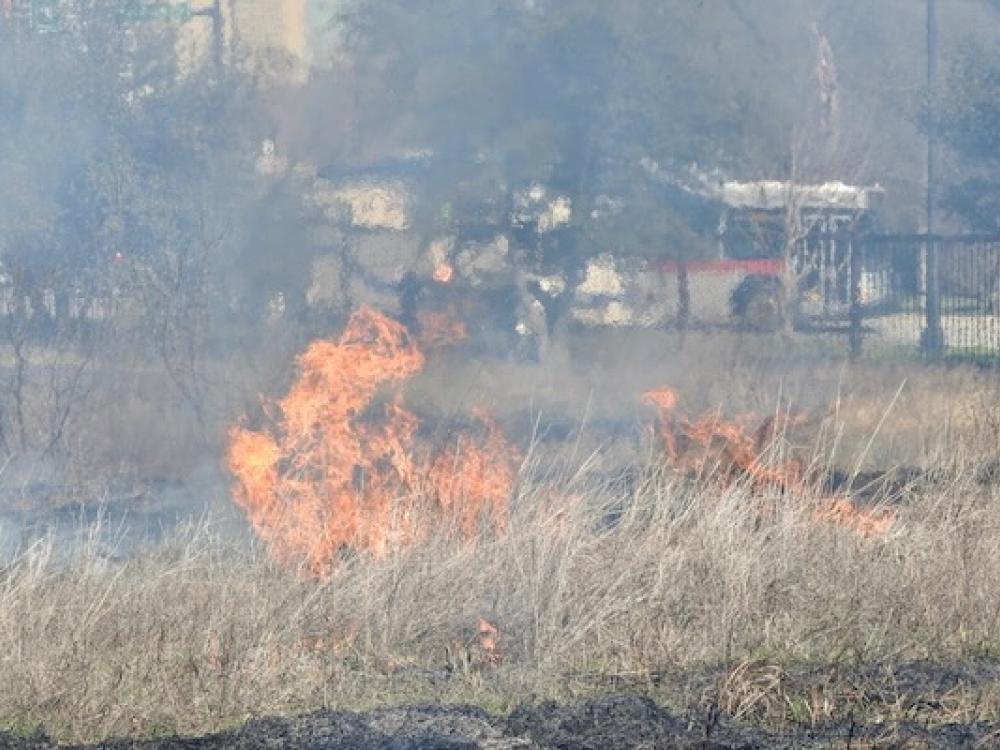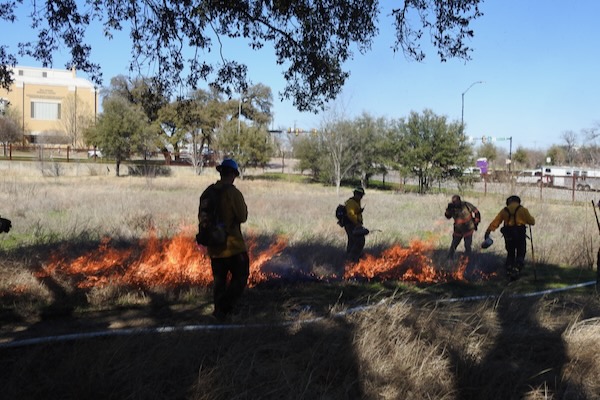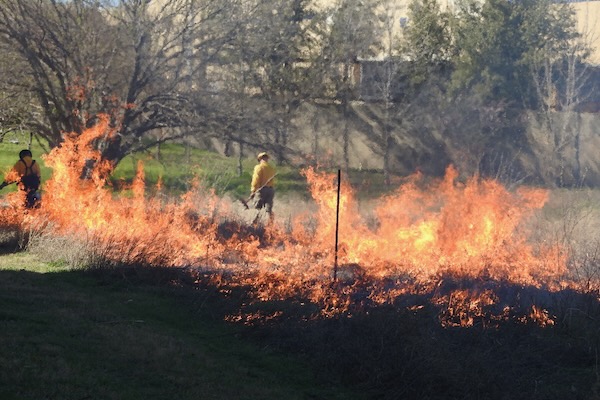
The Botanical Research Institute of Texas held its second prescribed burn in the heart of the Cultural District on March 3. Photo by Michael Smith.
March 10, 2023
Flames lapped across the prairie at the Botanical Research Institute of Texas in the Fort Worth Cultural District last Friday. The fire team scattered around the perimeter wasn't there to put it out. They started it.
The 1.5-acre cultivated prairie behind the BRIT building is located a block from Cowtown's world class museums, overlooking the heavily traveled University Drive.
A decade ago, after the BRIT building was built, the lot was seeded with iconic native grasses, like Indiangrass, little bluestem and sideoats grama. Last week was the second time BRIT enlisted a team of local experts to burn it.
Prairie advocates say that prairies are made of more than grasses and wildflowers. A prairie is made from rich soil and a community of grasses and other plants, pollinators — and occasional fires.
A fire team tends to a prescribed burn held at the Botanical Research Institute of Texas in Fort Worth Cultural District on March 3, 2023. Video by Michael Smith for GSDFW.
“Fire is a critical tool for maintaining healthy prairies,” said Carly Aulicky, North Texas director of outreach and stewardship for the Native Prairies Association of Texas.
She noted that “prairies are disturbance-dependent ecosystems,” meaning that they can’t just be left alone year after year. If that happened, shrubs and trees would establish, and other plants would move in. Little by little, the prairie would become shrub land or woods.
Brooke Best, the director of Texas plant conservation at BRIT, described fire as “mother nature’s management tool.” Small-scale fires help maintain a prairie, because native grasses and wildflowers can bounce back easily after a burn. Shrubs and other plants that are not part of the prairie come back more slowly, if at all.
She said that because the prescribed burn was held in the cool season, the fire wouldn’t kill bigger woody plants but will make them stand out more, so that they can be addressed using other methods.
TWICE BURNED
 Burn staff starting the back burn, a narrow strip along the border that keeps a head fire from crossing over. Photo by Michael Smith.
Burn staff starting the back burn, a narrow strip along the border that keeps a head fire from crossing over. Photo by Michael Smith.
This little prairie was burned before in January of 2021. The inaugural fire was directed by a carefully orchestrated team, including folks from the Fort Worth Nature Center and Refuge, the Texas A&M Forest Service, the Fort Worth Fire Department and BRIT. In 2021 and again this year, the “burn boss” was Daniel Price, natural resources manager for the Fort Worth Nature Center.
Price led a similar team this time representing several agencies. Craig Trojacek, public information officer with the Fort Worth Fire Department, said that the Fire Department was there, not only to help with any aspect of fire management, but also to respond to any medical emergency that could happen.
The team had a map showing the burn area and its boundaries. Price showed map overlays of wind speed and direction. The team had considered the possibility that smoke might cause trouble on nearby University Drive, but the conditions looked OK. Temperature and humidity were also factored in. The edges of the burn area had been mowed and watered as another safety precaution to make sure the fire was contained. Keeping people and property safe was, of course, the first priority.
And even though we understand the purpose of a prescribed burn, most of us need that reassurance that it is safe. Typically, fire is something to be prevented, never started on purpose. Nobody wants a wildfire. But periodic small fires, managed appropriately, can actually lower the risk of wildfire. When nothing is burned, over the years, dead brush or “thatch” from dead grasses can build up so much fuel that when a fire finally is started by accident, it is intense, severe and may get out of control.
LEARNING FROM THE BURN
 The fire team igniting bigger areas. Photo by Michael Smith.
The fire team igniting bigger areas. Photo by Michael Smith.
BRIT’s Brooke Best, who is a plant ecologist by training, has been following the results of the first fire during the past two years. She has studied such things as which plant species come back and the richness and life of the soil.
She is part of a community of local experts who contribute to our understanding of the prairie.
“We have a partnership with a faculty member at Weatherford College who comes out to sample root mycorrhizae (parts of fungi that work in partnership with plant roots) and the fungi in the soil. We can learn how that changes after a burn,” said Best.
Other people have learned from the burn, as well. She noted that the last two years provided opportunities for teachers and interns to join Best in sampling and getting other educational programs out into the prairie.
The current burn kept that educational aspect going. On the same day, BRIT hosted a workshop for municipal, environmental and fire professionals to learn about prescribed burns.
“We hope that the workshop surrounding the burn helps people connect with each other so that more people burn their own properties, their own parks,” she said.
Burning property probably sounds strange if you didn’t know that burning helps keep land healthy.
What happens to the animals when an area is burned? In the workshop, Fort Worth Nature Center’s Daniel Price recalled a time he was involved in burning a patch at the Nature Center. The team stopped in a non-burn patch to rest, and suddenly a group of wild pigs raced away from the fire and past the humans. Even rabbits and mice have a chance to run away from a burn area, so that there is very little loss of wildlife.
LIGHTING THE FLAME
 Flames jump higher in one area of the burn. Photo by Michael Smith.
Flames jump higher in one area of the burn. Photo by Michael Smith.
After lots of preparation and discussion, it was time to light the fire.
Personnel with drip torches — canisters that can drip and ignite fuel along a fire line — set a “backing fire” along one edge of the burn area. Getting that narrow strip burned created an area that a “head fire,” driven by the wind and spreading quickly, could not cross. Everything was engineered for control and safety.
There were moments of dramatic flames, despite the previous night’s rain. Nevertheless, the fire behaved just as it was supposed to. Most of the prairie was blackened and ready to receive the spring rain and sunshine, emerging once more as a beautiful patch of prairie near the heart of Fort Worth.
RELATED ARTICLES
BRIT uses fire to revive its urban prairie
Horses 'make hay' at the Botanical Research Institute of Texas
Plant 'museum' thriving in Fort Worth Cultural District
North Texas prairies have new advocate fighting for them
Pocket prairies patch together native Texas landscape
Create your own pocket prairie
Stay up to date on everything green in North Texas, including the latest news and events! Sign up for the weekly Green Source DFW Newsletter! Follow us on Facebook and Twitter. Also check out our new podcast The Texas Green Report, available on your favorite podcast app.









